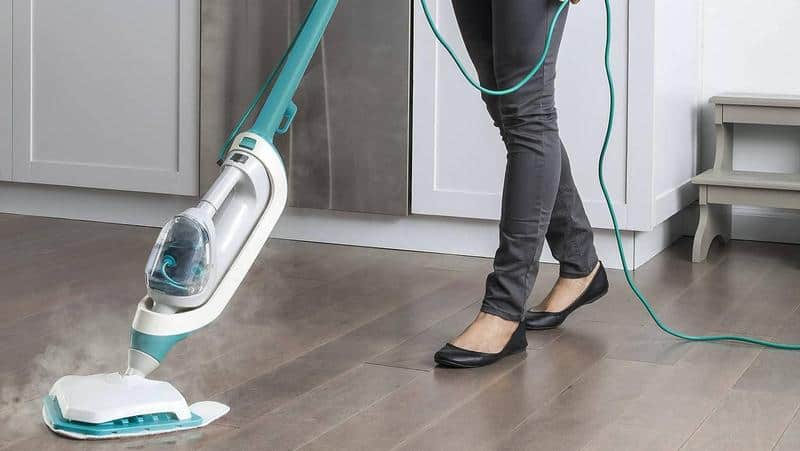Have you ever wondered about the safety of using a steam mop on your beautiful laminate floors? Are you worried about damaging that sleek, modern finish? You’re not alone. Many homeowners find themselves asking this question, balancing the desire for a deep clean with the fear of irreversible damage. But let’s dive into the world of steam mopping and laminate floors and discover the truth.

Image: www.archute.com
In this comprehensive guide, we’ll explore the pros and cons of using steam mops on laminate flooring. We’ll break down the science behind both steam and laminate, analyze the potential risks and benefits, and ultimately equip you with the knowledge to make an informed decision about your cleaning routine.
Understanding Laminate Floors
Laminate flooring, a popular choice for its durability and affordability, is a multi-layered product. The top layer, the one you see and walk on, is a durable melamine resin, crafted to mimic the look of natural materials like wood, tile, or stone. While generally resistant to moisture, laminate flooring has a specific weakness: the edges. The seams between planks, even when carefully installed, can be vulnerable to water intrusion.
The Science of Steam
Steam cleaning, a method that uses pressurized hot water vapor, has become increasingly popular for its effectiveness in killing bacteria and loosening dirt. However, the intense heat of the steam can potentially impact certain surfaces, including, you guessed it, laminate flooring.
The Potential Risks

Image: flooringstype.com
1. Warping and Swelling
One of the most significant concerns with steam mopping laminate floors is the risk of water seeping into the seams and causing the planks to warp or swell. Excess moisture can compromise the integrity of the laminate material, leading to uneven surfaces and potentially even buckling.
2. Damage to Finishes
The high temperature of the steam can potentially strip away protective finishes on laminate floors. The glossy sheen of some laminate boards might become dull or cloudy, affecting the overall aesthetic appeal and possibly affecting the longevity of the floor.
3. Voiding Warranties
It’s essential to consult the manufacturer’s instructions and warranty information for your specific laminate flooring. Many manufacturers explicitly state that steam mopping is not recommended and can void the warranty, leaving you without recourse if damage occurs. It’s always better to be safe than sorry.
The Potential Benefits
It’s not all doom and gloom. Steam mopping can offer some advantages, depending on the type of laminate floor you have and your cleaning approach.
1. Deep Cleaning Power
Steam mopping excels at deep cleaning, removing grime, stuck-on dirt, and even killing germs. It can be particularly effective for laminate floors that see a lot of foot traffic or are prone to spills.
2. Sanitizing Properties
Steam’s high temperature can effectively sanitize floors, killing bacteria and other microorganisms. This is especially beneficial in homes with pets, children, or individuals with allergies.
3. Minimal Chemicals
Many steam mops are designed to clean with just water, eliminating the need for harsh chemicals that can be harmful to you and your family. This is a significant advantage for those seeking eco-friendly cleaning options.
The Verdict: When is Steam Mopping Okay?
So, can you use a steam mop on laminate floors? The answer is a qualified “maybe.” The key factors to consider are the specific type of laminate flooring, the manufacturer’s recommendations, and your cleaning approach.
Here are some tips for using steam mops on laminate floors safely:
- Check Your Warranty: Always consult with your manufacturer’s guidelines and warranty information. If they advise against steam mopping, heed their warning.
- Low Steam Setting: If steam mopping is allowed, use the lowest steam setting possible. This minimizes the risk of excessive moisture penetration.
- Avoid Standing Water: Do not let steam linger on the floor or soak into the seams. The goal is to use steam quickly and efficiently without saturating the material.
- Test in an Inconspicuous Area: Before steam mopping your entire floor, try it in a small, hidden area first. This allows you to assess the reaction of the laminate to the steam and ensure it doesn’t cause any damage.
- Dry Thoroughly: Always dry laminate floors thoroughly after steam mopping, using a dry cloth or mop. This helps to prevent water from seeping into seams and causing problems.
Alternatives to Steam Mopping
If you’re hesitant about using a steam mop on your laminate floors, or if your warranty forbids it, don’t despair! There are other effective cleaning methods:
- Dry Mopping: A simple dust mop is a great way to pick up dirt and debris without using water. You can also use a microfiber mop with a dusting solution for a deeper clean.
- Spray Mop: A spray mop allows you to control the amount of liquid you use, minimizing the risk of over-saturation. Choose a cleaning solution specifically designed for laminate flooring.
- Vacuuming: Regular vacuuming with a hard floor attachment is an excellent way to remove loose dirt and dust. Be mindful of any delicate designs or textures on your laminate flooring.
Can U Use A Steam Mop On Laminate Floors
Conclusion
Navigating the world of laminate flooring and steam cleaning can be tricky, requiring careful consideration and a mindful approach. While steam mopping can offer deep cleaning power and sanitizing benefits, it’s essential to weigh the risks, especially the potential for warping and damage to finishes. By understanding the pros and cons, consulting manufacturer guidelines, and using caution, you can make an informed decision about the best cleaning practices for your laminate floors. Ultimately, prioritizing the longevity and beauty of your floors should be your guiding principle, ensuring they remain a source of style and comfort for years to come.





